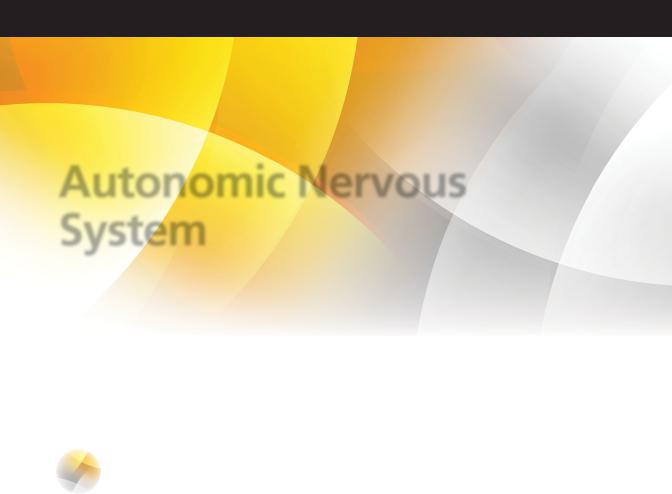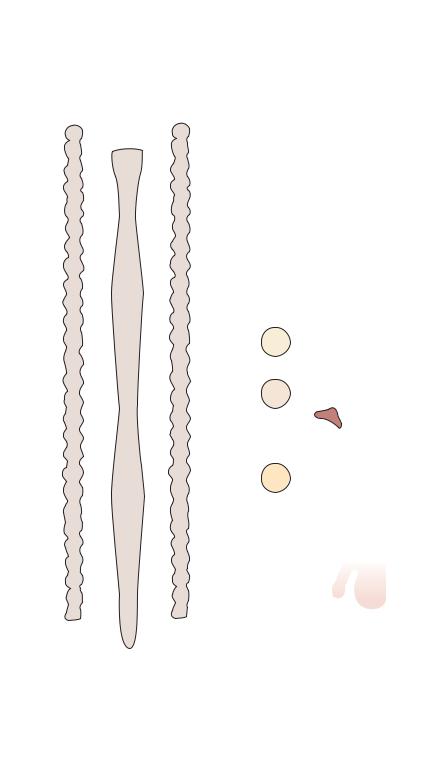
- •Objectives
- •Objectives
- •IX Congenital Malformations of the CNS
- •Objectives
- •VI Regeneration of Nerve Cells
- •Objectives
- •VI Venous Dural Sinuses
- •VII Angiography
- •Objectives
- •Objectives
- •IV Location of the Major Motor and Sensory Nuclei of the Spinal Cord
- •Case 6-1
- •Case 6-2
- •VII Conus Medullaris Syndrome (Cord Segments S3 to C0)
- •Objectives
- •Lesions of the Brainstem
- •Objectives
- •Objectives
- •VII The Facial Nerve (CN VII)
- •Objectives
- •IV Trigeminal Reflexes
- •Objectives
- •Objectives
- •IV Auditory Tests
- •Objectives
- •Objectives
- •VI Cortical and Subcortical Centers for Ocular Motility
- •VII Clinical Correlation
- •Objectives
- •IV Clinical Correlations
- •Objectives
- •Objectives
- •VI Cerebellar Syndromes and Tumors
- •Objectives
- •Objective
- •Objectives
- •I Major Neurotransmitters

C H A P T E R 8
Autonomic Nervous
System
Objectives
1.List the functions of the sympathetic and parasympathetic divisions of the autonomic nervous system (ANS), using Table 8.1 as a reference.
2.Describe the location(s) of the preand postganglionic cell bodies of the sympathetic and parasympathetic divisions of the ANS.
3.Trace the pathways that preand postganglionic fibers take to reach their destinations.
IIntroduction. The autonomic nervous system (ANS) is a general visceral efferent
motor system that controls and regulates smooth muscle, cardiac muscle, and glands.
A.The ANS consists of a two-neuron chain from the CNS to the effector: a preand postganglionic neuron.
B.Autonomic Output is generally reflexive and is influenced rostrally by the hypothalamus.
C.The ANS has three divisions:
1.Sympathetic (Figure 8-1).
●Prepares the body for action—fight or flight
●Uses a lot of energy, as it upregulates function in a nonspecific way
●Preganglionic cell bodies in the spinal cord between T1 and L2, form the intermediolateral cell column of the lateral horn.
●Postganglionic cell bodies are found in the sympathetic chain—primarily for innervation of the body wall (i.e., erector pili, blood vessels, and sweat glands) or in prevertebral ganglia for innervation of the gut.
2.Parasympathetic (Figure 8-2).
●Responsible for resting state of the body—rest and digest
●Conserves energy, functions more specifically because of the short postganglionic fibers (i.e., it can activate targets with more specificity)
●Preganglionic cell bodies in the brainstem—associated with CNs III, VII, IX, and X, and the sacral spinal cord S2-S4
●Postganglionic cell bodies are found in the ciliary, otic, pterygopalatine, or submandibular ganglia for the head—all postganglionic parasympathetic fibers in the head run in branches of CN V to reach their targets, and in the walls of the target organ for the body.
3.Enteric. The enteric nervous system is composed of the intramural ganglia of the gastrointestinal tract, submucosal plexus, and myenteric plexus.
70

To blood vessels, arrector pili, and sweat glands
Figure 8-1
|
Autonomic Nervous System |
71 |
|
Eye: superior |
|
|
tarsal muscle |
|
|
Lacrimal gland |
|
|
Dilator pupillae |
|
Superior |
Submandibular and |
|
sublingual glands |
|
|
cervical ganglion |
|
|
|
|
|
|
Parotid gland |
|
Heart
T1
|
Bronchial tree |
Celiac plexus |
|
Superior |
Stomach |
mesenteric plexus |
|
|
Small intestine |
Suprarenal medulla |
|
|
Large intestine |
Inferior |
|
mesenteric plexus |
|
L2
Ductus deferens
Sympathetic trunk
The sympathetic (thoracolumbar) innervation of the autonomic nervous system.
IICranial Nerves (CN) With Parasympathetic
Components include the following:
A.CN III—preganglionic cell bodies in the accessory oculomotor (Edinger–Westphal) nucleus; postganglionic cell bodies in the ciliary ganglion.

72 Chapter 8
Midbrain |
Accessory occulomotor |
|
nucleus |
||
|
Superior salivatory
Pons nucleus
Inferior salivatory nucleus 
Medulla Dorsal motor
nucleus of the vagus
S-2
S-3
S-4
Ciliary ganglion
CN III
Pterygopalatine ganglion
Submandibular ganglion
CN VII
CN IX Otic ganglion
CN X
Pelvic splanchnic nerves
Sphincter pupillae and ciliaris
Lacrimal and nasal glands
Submandibular and sublingual glands
Parotid gland
Heart
Bronchial tree
Stomach
Small intestine
Large intestine
Urinary bladder
Genital erectile tissue
Figure 8-2 The parasympathetic (craniosacral) innervation of the autonomic nervous system.
B.CN VII—preganglionic cell bodies in the superior salivatory nucleus; postganglionic cell bodies in the pterygopalatine and submandibular ganglia.
C.CN IX—preganglionic cell bodies in the inferior salivatory nucleus; postganglionic cell bodies in the otic ganglion.
D.CN X—preganglionic cell bodies in the dorsal motor nucleus of the vagus; postganglionic cell bodies in intramural ganglia.

Autonomic Nervous System |
73 |
IIICommunicating Rami include the following:
A.White Rami Communicantes, which are found between T-1 and L-2 and are myelinated. Carry visceral afferents and preganglionic sympathetic fibers to the sympathetic chain.
B.Gray Rami Communicantes, which are found at all spinal levels and are unmyelinated. Carry postganglionic sympathetic fibers to the spinal nerve.
IV Neurotransmitters of the ANS include the following:
A.Acetylcholine, which is the neurotransmitter of the preganglionic neurons, as well as the postganglionic parasympathetics.
B.Norepinephrine, which is the neurotransmitter of the postganglionic sympathetic neurons.
C.Dopamine, which is the neurotransmitter of the small, intensely fluorescent (SIF) cells, which are interneurons of the sympathetic ganglia.
VClinical Correlation
A.Megacolon (Hirschsprung Disease or Congenital Aganglionic Megacolon) is characterized by extreme dilation and hypertrophy of the colon, with fecal retention, and by the absence of ganglion cells in the myenteric plexus. It occurs when neural crest cells do not migrate into the colon.
B.Familial Dysautonomia (Riley–Day Syndrome) predominantly affects Jewish children. It is an autosomal recessive trait that is characterized by abnormal sweating, unstable blood pressure (e.g., orthostatic hypotension), difficulty in feeding (as a result of inadequate muscle tone in the gastrointestinal tract), and progressive sensory loss. It results in the loss of neurons in the autonomic and sensory ganglia.
C.Raynaud Disease is a painful disorder of the terminal arteries of the extremities. It is characterized by idiopathic paroxysmal bilateral cyanosis of the digits (as a result of arterial and arteriolar constriction because of cold or emotion). It may be treated by preganglionic sympathectomy.
D.Peptic Ulcer Disease results from excessive production of hydrochloric acid because of increased parasympathetic (tone) stimulation.
E.Horner Syndrome (see Chapter 14) is oculosympathetic paralysis. Characterized by ptosis, anhidrosis, miosis, and enophthalmos.
F.Shy–Drager Syndrome involves preganglionic sympathetic neurons. It is characterized by orthostatic hypotension, anhidrosis, impotence, and bladder atonicity.
G.Botulism. The toxin of Clostridium botulinum blocks the release of acetylcholine and results in paralysis of striated muscles. Autonomic effects include dry eyes, dry mouth, and gastrointestinal ileus (bowel obstruction).
H.Lambert–Eaton Myasthenic Syndrome is a preganglionic disorder of neuromuscular transmission in which acetylcholine release is impaired, resulting in autonomic dysfunction (such as dry mouth) as well as proximal muscle weakness and abnormal tendon reflexes.

74 Chapter 8
Table 8-1: Sympathetic and Parasympathetic Activity on Organ Systems
Structure |
Sympathetic Function |
Parasympathetic Function |
Eye |
|
|
Radial muscle of iris |
Dilation of pupil (mydriasis) |
|
Circular muscle of iris |
|
Constriction of pupil (miosis) |
Ciliary muscle of ciliary body |
|
Contraction for near vision |
Lacrimal glands |
|
Stimulation of secretion |
Salivary glands |
Viscous secretion |
Watery secretion |
Sweat glands |
|
|
Thermoregulatory |
Increase |
|
Apocrine (stress) |
Increase |
|
Heart |
|
|
Sinoatrial node |
Acceleration |
Deceleration (vagal arrest) |
Atrioventricular node |
Increase in conduction velocity |
Decrease in conduction velocity |
Contractility |
Increase |
Decrease (atria) |
Vascular smooth muscle |
|
|
Skin, splanchnic vessels |
Contraction |
|
Skeletal muscle vessels |
Relaxation |
|
Bronchiolar smooth muscle |
Relaxation |
Contraction |
Gastrointestinal tract |
|
|
Smooth muscle |
|
|
Walls |
Relaxation |
Contraction |
Sphincters |
Contraction |
Relaxation |
Secretions and motility |
Decrease |
Increase |
Genitourinary tract |
|
|
Smooth muscle |
|
|
Bladder wall |
Little or no effect |
Contraction |
Sphincter |
Contraction |
Relaxation |
Penis, seminal vesicles |
Ejaculationa |
Erectiona |
Adrenal medulla |
Secretion of epinephrine and norepinephrine |
|
Metabolic functions |
|
|
Liver |
Gluconeogenesis and glycogenolysis |
|
Fat cells |
Lipolysis |
|
Kidney |
Renin release |
|
aNote erection versus ejaculation: Remember point and shoot, where p, parasympathetic; s, sympathetic. Reprinted from Fix J. BRS Neuroanatomy. Media, PA: Williams & Wilkins; 1991, with permission.
